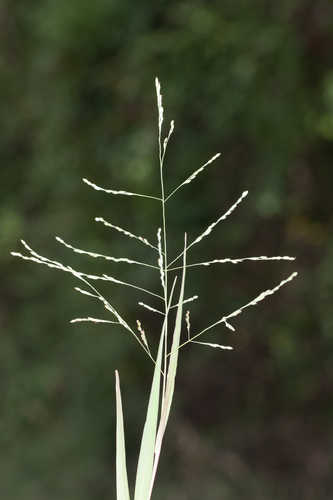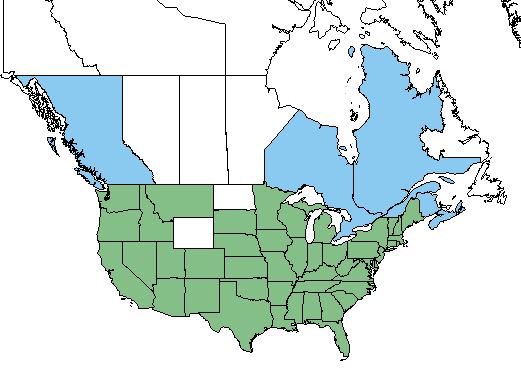Panicum dichotomiflorum
Common Names: Bartow panic grass; Spreading panic grass; Fall panic grass; Puritan panic grass[1]
| Panicum dichotomiflorum | |
|---|---|

| |
| Photo by John Gwaltney hosted at Southeastern Flora.com | |
| Scientific classification | |
| Kingdom: | Plantae |
| Division: | Magnoliophyta - Flowering plants |
| Class: | Liliopsida – Monocotyledons |
| Order: | Poales |
| Family: | Poaceae |
| Genus: | Panicum |
| Species: | P. dichotomiflorum |
| Binomial name | |
| Panicum dichotomiflorum Michx. | |

| |
| Natural range of Panicum dichotomiflorum from USDA NRCS Plants Database. | |
Contents
Taxonomic Notes
Synonyms: none.[1]
Varieties: Panicum dichotomiflorum Michaux var. bartowense (Scribner & Merrill) Fernald; Panicum dichotomiflorum Michaux var. dichotomiflorum; Panicum dichotomiflorum Michaux var. puritanorum Svenson.[1]
Description
P. dichotomiflorum is an annual graminoid of the Poaceae family that is native to North America.[2]
Var. puritanorum is distinguishable by its ovoid to slenderly ellipsoid spikelets, which are 1.6-2.3 mm long, widest at the middle, and have acute tips. The second glume and sterile lemma are thin and submembraneous. Its many pedicels are larger than 3 mm long and longer than spikelets. The culms are 6 dm long and the leaf blades 1-8 mm wide.[1]
The two other varieties have oblong-lanceolate spikelets that are 2.4-3.6 mm long, widest below the middle, and taper to acuminate tips. Their second glume and sterile lemma are firm and subcoriaceous. Most pedicels are longer than 3 mm and shortern than spikelets. The culms are 20 dm long and the leaf blades are 4-20 mm wide. The mature plant is usually spreading to ascending, 5-10 (20) dm long.[1]
Var. bartowense has conspicuously papillose-hispid sheaths, ligules that are 1.5-3 mm long; and spikelets that are 2.3-2.8 mm long. The mature plant is stout and erect, averaging 10-20 dm long. Finally, var. dichotomiflorum has glabrous to sparsely pilose sheaths, where the hairs are not papillose-based. Its ligule is 1-2 mm long and the spikelets are 2.3-3.8 mm long.[1]
Distribution
Excepting North Dakota and Wyoming, P. dichotomiflorum is native to the United States, and has been introduced to British Columbia, Ontario, and Quebec.[2] Var. bartowense is found in Florida, the Bahamas, and Cuba. Var. dichotomiflorum ranges from East Canada, west to the British Columbia, and south to Florida and Texas. It's also found in the Bahamas. Finally, the range of var. puritanorum extends from Novia Scotia, New Hampshire, and NewYork, south to Deleware, Virginia, and North Carolina, with disjunct populations in Indiana and Illinois.[1]
Panicum dichotomiflorum var. puritanorum is endemic to an area from southeastern Massachusetts to southern New Jersey and adjacent Delmarva Peninsual.[3]
Ecology
Habitat
Moist habitats such as streams, floodplains, wet clearings, and waste sites are common environments to find P. dichotomiflorum. It requires full sun.[2] Marshes are also common environments for the species.[4]
This grass is considered an indicator of anaerobic and compacted soil.[2]
Phenology
P. dichotomiflorum flowers from July through October.[1] Var. bartowense has an extended blooming period, beginning in June and continuing to December.[1]
Seed dispersal
Seeds will fall off the stalks and into water and the ground, likely picked up by animals and dispersed.[2]
Seed bank and germination
Shallow flooding after seed dispersal is ideal for maximum germination.[2]
Germination will occur between April and May.[2]
Temperatures of 80F+ is ideal for proper germination.[2]
Use by animals
Small birds and ducks will was the seeds of the grass and deer will use it for browse.[2] It can be a major food source for ducks in a managed impoundment in South Carolina.[5]
P. dichotomiflorum has been known to cause photo-sensitivity to livestock as well as extreme nitrate poisoning.[2]
Conservation, cultivation, and restoration
Planting a shade canopy will block the necessary sun light for P. dichotomiflorum is grow.[2]
Cultural use
Photo Gallery
References and notes
- ↑ 1.0 1.1 1.2 1.3 1.4 1.5 1.6 1.7 1.8 Weakley, A.S. 2015. Flora of the southern and mid-atlantic states. Working Draft of 21 May 2015. University of North Carolina at Chapel Hill, Chapel Hill, North Carolina.
- ↑ 2.00 2.01 2.02 2.03 2.04 2.05 2.06 2.07 2.08 2.09 2.10 USDA Plant Database
- ↑ Sorrie, B. A. and A. S. Weakley 2001. Coastal Plain valcular plant endemics: Phytogeographic patterns. Castanea 66: 50-82.
- ↑ Bostick, P. E. (1971). "Vascular Plants of Panola Mountian, Georgia " Castanea 46(3): 194-209.
- ↑ Landers, J. L., et al. (1976). "Duck Foods in Managed Tidal Impoundments in South Carolina." The Journal of Wildlife Management 40(4): 721-728.